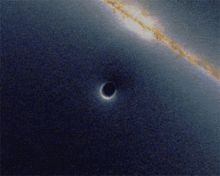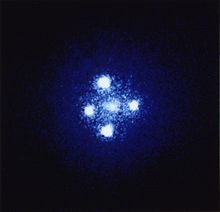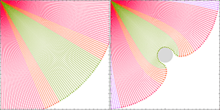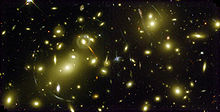Gravitational lens
In astronomy, the gravitational lens effect is the deflection of light by large masses. The name derives from the analogy to optical lenses and the acting force gravity.
Basically, the light from a distant source such as a star, galaxy or other astronomical object is affected by an object in front of it as seen by the observer, the gravitational lens.
Light rays deflected by a gravitational lens are deflected more towards the mass the closer they pass the deflecting mass. A gravitational lens concentrates the light passing the deflecting mass on the axis between the object and the observer. However, light rays passing by the object at different distances intersect the axis at different distances. As a result, a gravitational lens cannot produce a real image in the sense of imaging optics. The light distribution produced instead is a caustic.
In the gravitational field of the gravitational lens, the direction of propagation of the light changes, so that the position of the source in the sky appears shifted. Its image can also be amplified, distorted or even multiplied in the process. According to the Odd-Number-Theorem there is always an odd number of images. However, some images can also be so strongly attenuated that only an even number can be observed.
Depending on the mass and shape (mass distribution) of the objects involved and their position relative to each other, the effect can vary in intensity, from spectacularly distorted multiple images to only slight changes in brightness, so that one speaks of the Strong Gravitational Lensing Effect, the Weak Gravitational Lensing Effect and the Microlensing Effect. A special case of the gravitational lensing effect is cosmic shear.
Already in 1704 Isaac Newton suspected the gravitational deflection of light in the famous Queries No. 1 of his work Opticks. The first quantitative consideration of it was around 1800, but it was first correctly described by Albert Einstein in 1915/16 with his General Theory of Relativity. After the first observations of the Sun in 1919 and some theoretical work, however, it was not until 1979 that observations of further gravitational lensing were achieved thanks to improved observational techniques. Since then, gravitational lensing has become a diverse field of observational astronomy and also a tool for other fields such as cosmology.

Simulation of the gravitational lensing effect

The Einstein cross: The quasar QSO 2237+0305, as seen from Earth, is located exactly behind the nucleus of a galaxy about 400 million light-years away, which acts as a gravitational lens. The gravitational lens produces four similarly bright images in the form of a cross with the galaxy nucleus in the center.
History
See also: Tests of the general theory of relativity
The first specific experimental test of the general theory of relativity (ART), which caused a great stir among the public and made this theory famous, was carried out in 1919. It verified the prediction of ART that light, like any electromagnetic radiation, is deflected in a gravitational field. It took advantage of the solar eclipse of May 29, 1919, to measure the apparent shift in the position of a star near the solar disk, since this is where the effect should be strongest. The prediction of Einstein's theory that starlight grazing the edge of the solar disk on its way to Earth should be deflected by 1.75 arc seconds was confirmed in this original measurement, with a deviation of 20%.
Classically, i.e. with the help of Newton's theory of gravitation, or calculated with the help of special relativity, the effect would only be half as great, since only the time coordinate changes and not the space coordinate. The deflection of 0.83 arc seconds resulting from Newton's theory of gravitation had already been calculated by Johann Georg von Soldner in March 1801.
Similar measurements were later made with improved instruments. In the 1960s, the positions of quasars were measured, achieving an accuracy of 1.5%, while similar measurements with the VLBI (Very Long Baseline Interferometry) later increased the accuracy to 0.2%. The positions of 100,000 stars were also measured by ESA's Hipparcos satellite, which verified the predictions of ART to within 0.1%. ESA's Gaia spacecraft, which was launched on 19 December 2013, is expected to measure the positions of more than a billion stars and thus determine the curvature of space even more accurately.
Phenomenology
Principle
Objects with a very large mass direct electromagnetic waves in a different direction. Accordingly, the image of the background object is shifted, distorted and possibly multiplied.
A special manifestation is the microlensing effect. Here, the deflection is so slight that it is not registered as a spatial shift, but instead becomes noticeable as a temporary increase in brightness.
In any case, the effect is based on the curvature of space by mass-containing objects or energy described by Albert Einstein in his general theory of relativity as the effect of gravity on space-time.
This effect can be demonstrated during a total solar eclipse on stars that are very close to the viewing direction of the sun and are otherwise outshone by it: The position of these stars then appears slightly shifted away from the Sun. The corresponding observation by Arthur Eddington provided the first experimental confirmation of general relativity in 1919. Einstein thought it possible, but hardly probable, that multiple images of the same object could be perceived under suitable conditions. However, he only thought of stars as triggering this effect; in 1937 Fritz Zwicky investigated the effect that a galaxy could have as a gravitational lens. In 1963 Yu. G. Klimov, S. Liebes and Sjur Refsdal independently realized that then quasars are ideal light sources for this effect.
Strong gravitational lensing effect
To obtain a gravitational lens in the usual, i.e. astronomical sense, the extremely intense gravitational fields of astronomical objects such as black holes, galaxies or clusters of galaxies are normally required. In the case of these, it is possible that a light source lying behind the gravitational lens not only appears displaced, but that the observer sees several images. The first such "strong gravitational lens" was discovered in 1979: the "twin quasar" Q0957+561. A well-known example is the Einstein cross in the constellation Pegasus, discovered in 1985, which is a quadruple image of the same object. Under certain circumstances, the object appears behind the gravitational lens as a closed line in the form of an Einstein ring.
The first gravitational lensing consisting not of a single galaxy but of a cluster of galaxies (Abell 370) was independently identified as such in 1987 by Genevieve Soucail, Yannick Mellier and others in Toulouse and by Vahé Petrosian and Roger Lynds in the USA.
Weak gravitational lensing effect
In the case of weak distortions - due to a weak or distant gravitational field - the effects of gravitational lensing are not directly apparent because the actual shape of the objects behind the gravitational lens is not known. In this case, the determination of the gravitational field is nevertheless possible by statistical methods, by examining the shape and orientation of many of the galaxies present in the background. Here one assumes that the orientation of the galaxies in the background would be random without a gravitational lens. With gravitational lensing, background shear is obtained so that galaxies appear more often aligned along a ring around regions of strong gravitational field. From this, the mass distribution that causes the lensing effect can be determined.
Since this effect is small, a large number of galaxies must be studied for sufficient statistical significance. Furthermore, a number of possible systematic errors have to be considered. These include the intrinsic shape of galaxies, the point spread function of the camera used, imaging errors of the telescope, and possibly the air turbulence of the Earth's atmosphere, which can also lead to a distortion of the image.
Microlensing effect
Main article: Microlensing effect
Contrary to Einstein's assumption (see above), the effects that a single star exerts on the radiation of a background object can also be observed. Thus, a number of MACHOs have been detected because a single star has focused the light of a much fainter object behind it and thus amplified it (briefly). Extrasolar planets have also been detected with this effect.
The focal point of the Sun's lensing effect lies at a distance of about 82.5 billion kilometers, or about 550 astronomical units, and would yield a magnification by a factor of about 100 million.
In extreme cases, the gravity of a galaxy can produce extreme magnification. This made it possible, for example, to discover the most distant star, MACS J1149 Lensed Star 1, which is 9 billion light years away (as of 2018).

Simulation of light deflection at a neutron star

left: undeflected beam in vacuum, right: beams deflected by a black hole (animation)

Far away galaxies appear as segments of a circle, here Abell 2218

Gravitational lens - principle representation
Questions and Answers
Q: What is gravitational lensing?
A: Gravitational lensing is a phenomenon caused by a massive object that bends the light around it, creating the appearance of multiple objects where there is only one.
Q: What causes gravitational lensing?
A: Gravitational lensing is caused by the presence of a massive body, such as a galaxy or black hole, between a distant object and us.
Q: How does a massive body create gravitational lensing?
A: The massive body creates a strong gravitational field that bends the path of the light from the distant object, causing it to converge and appear as if it is coming from multiple sources.
Q: What determines the nature of the gravitational lensing effect?
A: The exact nature of the gravitational lensing effect depends on various factors such as the mass and distance of the massive body, as well as the distance between the object and ourselves.
Q: Can gravitational lensing affect the appearance of distant objects?
A: Yes, gravitational lensing can affect the appearance of distant objects by creating the illusion of multiple objects as a result of the bending of light.
Q: How does gravitational lensing help astronomers study space?
A: Gravitational lensing can provide important information to astronomers by allowing them to study the distribution of matter in the universe, estimate the mass of the massive bodies causing the lensing, and identify distant and faint objects that would otherwise be difficult to detect.
Q: Is gravitational lensing a common phenomenon in space?
A: Gravitational lensing is relatively common in space due to the presence of massive bodies such as galaxies and black holes. However, it requires specific alignment and conditions to be observable from Earth.
Search within the encyclopedia